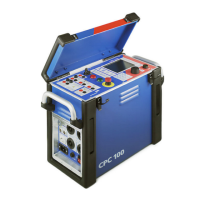State 2: "wait for the CB to close"
Short dead time. Set to output 50A until the "Overload" trigger
condition that started state 2 clears.
The measurement table shows for state 2 that the short dead time +
the CB closing time lasted 477 ms. This time also includes the
additional time to compensate for the debounce (see note).
The actual value for CB close equals 477 ms - 100 ms = 377 ms.
Note that the r.m.s. measurement of I Out reacts slow and therefore
the measurement table does not show the full current.
State 1: "wait for the CB to open"
Set to output 400 A until the trigger condition "Overload" occurs.
Here, trigger condition "Overload" means: The CPC 100 cannot
provide the 400 A any longer because of the opening CB contact.
Therefore, the opening CB contact terminates state 1.
The measurement table shows for state 1 that the relay time + the CB
opening time lasted 290 ms.
State 4: "wait for the CB to close"
Long dead time. Set to output 50A
*)
until the "Overload" trigger
condition that started state 4 clears.
The measurement table shows for state 4 that the long dead time +
the CB closing time lasted 3.191 s. This time also includes the
additional time to compensate for the debounce (see note).
The actual value for CB close equals 3.191 s - 100 ms = 3.091 s.
*)
Current values < 50 A do not initiate an "Overload" when the current
circuit opens. For this reason, a nominal current value of 50A was chosen
here, even though the CB is open.
State 3: "wait for the CB to open"
Like state 1, see previous figure.
Note: For debouncing purposes, at CB closing time measurements, the CPC 100 adds a fixed
time of 100 ms to the measured value. In order to determine the true CB closing time value,
these 100 ms need to be deducted from the value displayed in the measurement table.
Time sequence of the four states to test the autoreclosure cycle
*) State 2 and 4 incl. the additional 100 ms the CPC 100 adds to compensate for the debounce
(see note above).

